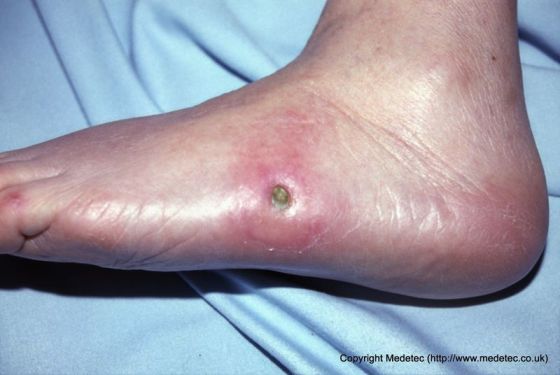At-Risk Patient: Diabetic Foot Ulcers
Patients with diabetes have a higher risk of ulceration, typically on the lower extremities. Other factors contributing to the risk of foot ulceration include peripheral neuropathy, peripheral arterial disease, infection and pressure.
Symptoms of Diabetic Foot Ulcers
Neuropathy, a major contributing factor in the development of diabetic foot ulcers, may present as a stinging, burning or shooting pain in the lower extremities that over time may progress to a loss of sensation in the feet or may initially develop as a progressive loss of sensation. This loss of feeling can cause patients with diabetes to further injure their feet and legs, opening them to infection and thus, ulceration.

Figure 1: Small, deep diabetic foot ulceration on lateral aspect of foot
Etiology
Neuropathy is most commonly associated with diabetes. Other causes include alcoholism, spinal cord injury, rheumatoid arthritis and Hansen's Disease.
Risk Factors
Patients with diabetes are at greater risk for developing diabetic foot ulcers if they fail to maintain their feet, perform daily inspections, keep the nails trimmed and regularly visit a podiatrist. Poorly fitting shoes and walking barefoot also dramatically increase the risk of developing a foot ulcer. Beyond the foot itself, other contributing risk factors include increasing age, hypertension, hypercholesterolemia, poor glycemic control (Hgb A1C < 5-6 and FBS 110-130), duration of diabetes, peripheral vascular disease, smoking cigarettes, and increased potential for infection. Wounds with a high risk for infection and ulceration include deep wounds, long lasting wounds, recurrent wounds and wounds from trauma.
Complications
Failure to avoid or control risk factors can result in the development of foot ulcers which can frequently require the amputation of the lower extremity. Arterial insufficiency can be a major contributing factor to an ulcers inability to heal properly and will require further treatment.
Diagnostic Studies
Assessment of neuropathy is conducted using a vibration perception threshold meter, the Semmes-Weinstein monofilament test or a tuning fork. Further assessment of the appearance of the feet can reveal pressure points which increase the risk of ulcer development and determine if existing injuries and callouses are pre-ulcerous.
Treatment & Prevention of Diabetic Foot Ulcers
For the at-risk patient, treatment of diabetic foot ulcers starts with prevention. This involves performing daily foot inspections, cleansing and moisturizing, as well as regular visits to the podiatrist. Care must be taken to ensure that well-fitted footwear is worn at all times. Minor wounds should be treated thoroughly and immediately. Additionally, proper nutritional support is key to both the avoidance and healing of diabetic foot ulcers.
References
Armstrong DG, Lavery LA. Diabetic Foot Ulcers: Prevention, Diagnosis and Classification. Am Fam Physician. 1998; 57(6): 1325-1332. Coy Decoste K. Diabetes Care Meets Wound Prevention: Preparing Patients for the Foot Exam. WoundSource. 2012. http://www.woundsource.com/blog/diabetes-care-meets-wound-prevention-pr…. Accessed on July 12, 2013. Lavery LA, Wunderlich RP, Wendel CS. Risk Factors for Foot Infections in Individuals With Diabetes. Diabetes Care. 2006; 29(6): 1288-1293. Meyers LA. The Diabetic Foot: An Overview. WoundSource. 2013. http://www.woundsource.com/blog/diabetic-foot-overview . Accessed on July 11, 2013. Neuropathic Ulcers. In: Wound and Skin Care Clinical Guidelines. Vancouver Island Health Authority. April 2007. Swezey L. Diabetic Foot – Risk Factors and Prevention. WoundSource. 2013. http://www.woundsource.com/blog/diabetic-foot-risk-factors-and-preventi…. Accessed on July 12, 2013. Images copyright Medetec (www.medetec.co.uk). Used with permission.







